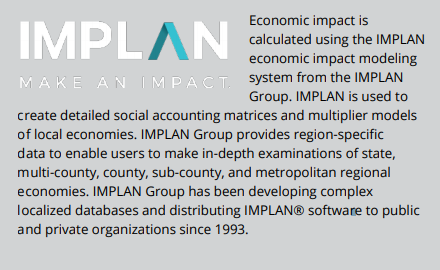Economic Impact Study 2018
Methodology for this Study
To identify and estimate the total economic contribution that a project, business entity, or activity makes to the local, regional, and state economies, it is necessary to look beyond the direct expenditures made by the business or activity itself. There is an economic “ripple effect” of the expenditures made for goods and services related to the business or activity. Spending cycles through the economy as direct expenses, such as purchases made at the grocery store, which are in turn paid out as wages to store workers, who in turn spend money. Wages paid to workers are spent on housing, food, clothing, entertainment, etc. This multiplier effect is accounted for both in terms of indirect effects of the direct spending, as well as induced effects (essentially, the further effects of the indirect spending) to calculate total economic impact.
The “multiplier effect” refers to the recurrent economic activity generated by an initial expenditure. For example, money spent directly on construction will cycle through the local economy again as wages to workers, purchases of construction materials (such as lumber, tools, and nails), gasoline for machinery, and worker transportation. The initial wave of spending generates a second and third wave of spending as wages paid and profits made on the direct construction spending spin through the economy in several cycles. Thus, the original direct expenditure yields a greater economic impact than just the money initially spent. Some money “leaks out” of the regional economy at each level because of spending made outside the area (for example, some goods may be purchased from another state). As a result, the subsequent spending cycles decrease in impact.
This study quantifies the total annual economic contribution of spending related to the University of Wisconsin System, including its campuses and related organizations and activities. The spending of UW System students, employees, and visitors, as well as spending on university operations, was compiled from various sources. The UW System budget office supplied university spending data. Student spending data was derived from prior NorthStar studies that included student expenditure surveys at several UW System campuses. This data in turn is processed in an econometric model to produce estimates of economic impact, jobs, and tax revenues.
The study quantifies the total economic contribution of spending related to the UW System.
Economic multiplier models (sometimes called Input/Output models) are the framework for analyzing economic impact. Derived mathematically, these models estimate the magnitude and distribution of economic impacts, and measure three types of effects: direct, indirect, and induced changes within the economy. Direct effects are determined by the amount of the initial spending. Indirect effects are determined by the amount of the direct effect spending within the study region on supplies, services, labor, and taxes. Finally, the induced effect measures the money that is re-spent in the study area as a result of spending from the indirect effect. Each of these steps recognizes that some money “leaks out” of the economic study region through purchases made outside the defined area. Eventually these leakages will slow or stop the cycle.
 For this project, the econometric model used is produced by the IMPLAN Group, Inc. (IMPLAN). IMPLAN is the developer of the IMPLAN® economic impact modeling system, which is used to create complete, extremely detailed Social Accounting Matrices and Multiplier Models of local economies. IMPLAN tools are in use by more than 2,000 public and private institutions. The University of Wisconsin–Whitewater Fiscal and Economic Research Center (FERC) was engaged to run the economic impact numbers. FERC uses the IMPLAN model and regularly updates the multipliers used in the model. Dr. Russ Kashian, director of FERC, was very helpful in running and analyzing the data in this study.
For this project, the econometric model used is produced by the IMPLAN Group, Inc. (IMPLAN). IMPLAN is the developer of the IMPLAN® economic impact modeling system, which is used to create complete, extremely detailed Social Accounting Matrices and Multiplier Models of local economies. IMPLAN tools are in use by more than 2,000 public and private institutions. The University of Wisconsin–Whitewater Fiscal and Economic Research Center (FERC) was engaged to run the economic impact numbers. FERC uses the IMPLAN model and regularly updates the multipliers used in the model. Dr. Russ Kashian, director of FERC, was very helpful in running and analyzing the data in this study.
